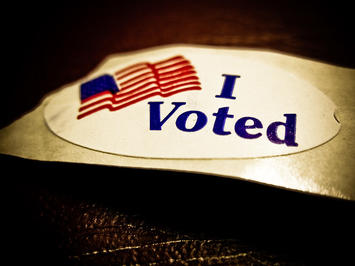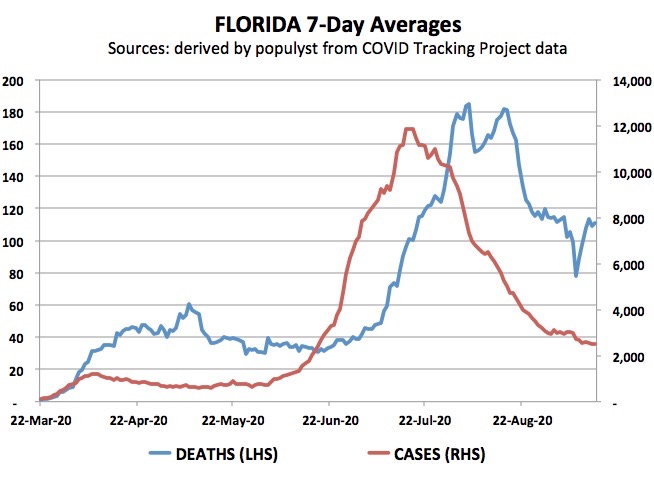
Former mayor Mike Bloomberg has announced that he would spend as much as $100 million of his own money to help Vice-President Biden prevail in Florida on Election Day. This underscores once again the importance of Florida in this and every presidential contest.
Florida has a good track record of picking the winner in a presidential election. With the messy 2000 contest between George W. Bush and Al Gore, the state gained prominence as the ultimate prize and must-win battleground. To be sure, it is not a perfect track record, given that Florida favored George H. W. Bush in 1992 and Richard Nixon in 1960 over winners Bill Clinton and John Kennedy. If you go to earlier times, you also find that Floridians misfired with John Davis and James Cox in 1924 and 1920, two unknowns today except among aficionados of electoral history. But in sum, four misses out of 25 elections over a century can indeed be called a strong track record.
The stakes are high in 2020 given the state’s 29 Electoral College votes and the tightness of the race according to the polls. Vice President Biden is now nominally ahead by 1 to 3%, an insignificant gap that can easily close or widen in the remaining days of the campaign, depending on a slew of factors, not least the performance of each candidate in the upcoming debates.
In 2016, candidate Trump won the state by a plurality of 48.6% to Hillary Clinton’s 47.4%, a lead so slim that it would not be deemed meaningful in a poll today. In the same pattern seen across other states, Clinton carried the large urbanized counties encompassing the Miami-West Palm Beach corridor, Orlando, Gainesville (home to the University of Florida), Tampa and Tallahassee while Trump swept all rural states and also managed to prevail in some smaller cities such as St Petersburg, Fort Myers and Jacksonville. In 2008 and 2012, Obama won Florida by margins of 2.5% over John McCain and 0.9% over Mitt Romney, with roughly the same urban-rural divide as in 2016. There is little doubt that the map will look the same in 2020, with some variances that may or may not in the aggregate tip the state to the Democrats.
2020 vs. 2016
The questions then are what has changed since 2016 and are these changes important enough to overcome other factors?
ONE, the population of Florida has grown by about 5% from 20.6 million in 2016 to an estimated 21.6 million in 2020, with over 90% of this growth coming from migration from other states and from foreign immigration. Owing to the large number of older people, Florida’s natural growth rate (births minus deaths) only adds about 20,000 to the population annually. The overall population growth is neutral or marginally positive for Biden as most migration originates from blue Northeastern states or from Puerto Rico and Latin America.
It is estimated that over 100,000 Puerto Ricans relocated to Florida (and many more to other states) after hurricane Maria devastated the island in 2017. Assuming that they vote, they could make a difference for Biden in a close election, given that not all are pleased with President Trump’s handling of Puerto Rico in the days after Maria. More broadly in other US states, the Hispanic vote would favor Democrats but the case of Florida is complicated by a large contingent of Cuban-Americans who generally prefer the harder line Republican stance towards the Cuban regime.
TWO, the number of people aged 64 and over has grown faster than other age groups, which means that Florida has gotten older since 2016 and will continue to get older. In theory, this would benefit the President because he usually polls better with older age groups but the change does not seem significant enough to neutralize the margin of error or other factors. Still, it can be considered a net plus for Trump on the margin. And in Florida, everything on the margin can make a difference.
THREE, the number of people declaring no party affiliation has continued to grow, an indication that independents could weigh more in this and future elections. They tend to make up their minds in the final weeks of the campaign in October and early November, a delay that increases the possibility of earlier polls being wide off the mark. This is of no particular advantage to either candidate but adds uncertainty to the current polls.
New Factors
Among non-demographic factors is of course the coronavirus pandemic. It hit Florida severely in the summer and has caused nearly 13,000 deaths so far. Because the state sees over 200,000 deaths in a typical year, these excess pandemic deaths add 6 to 7% to the total, an incidence that is tragic for the next of kin but that can go largely unnoticed by the vast majority of people whose families were untouched. In addition, a sizable segment of Trump supporters see the pandemic as a hoax or at least an exaggeration, a stance that binds them to the President whom they see as a bulwark against the spread of conspiracies by the nefarious (in their view) elite media. In the end, the pandemic is likely to prove neutral for both candidates, with each constituency looking at it through its own political lens.

More important are the economic consequences of the pandemic. Florida was hurt by the shuttering of several sectors, not least travel and hospitality, two of the pillars of the state economy. But here again, some people will blame the President for mishandling the crisis while others will blame alarmist elements of the media and elites for encouraging a lockdown in this or other parts of the country. The notion that the lockdowns were more damaging to the economy than the pandemic has many adherents in Florida and other states, including among some well-heeled researchers and academics. Because Trump is blamed by some for the mishandling of the pandemic and Biden is seen by others as more likely to impose future lockdowns, the impact of the pandemic economy on electoral choices is likely a wash.
Read the rest of this piece at Populyst.
Sami J. Karam is the founder and editor of populyst.net and the creator of the populyst index™. populyst is about innovation, demography and society. Before populyst, he was the founder and manager of the Seven Global funds and a fund manager at leading asset managers in Boston and New York.
Photo credit: Vox Efx via Flickr under CC 2.0 License.












